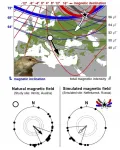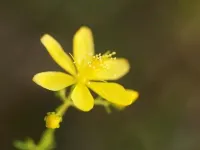Birds can 'read' the Earth's magnetic signature well enough to get back on course
Research shows for the first time, how birds displaced beyond their normal migratory route are able to navigate back to their route and gives us an insight into how they accomplish this feat.
2021-02-12
(Press-News.org) Birdwatchers get very excited when a 'rare' migratory bird makes landfall having been blown off-course and flown beyond its normal range. But these are rare for a reason; most birds that have made the journey before are able to correct for large displacements and find their final destination.
Now, new research by an international team shows for the first time, how birds displaced in this way are able to navigate back to their migratory route and gives us an insight into how they accomplish this feat.
Writing in Current Biology, the team from Bangor and Keele Universities describe how reed warblers can navigate from a 'magnetic position' beyond what they have experienced in their normal migration route, back towards that correct route.
Different parts of the Earth have a distinct 'geomagnetic signature' according to their location. This is a combination of the strength of the geomagnetic field, the magnetic inclination or the dip angle between magnetic field lines and the horizon and the magnetic declination, or the angle between directions to the geographic and magnetic North poles.
Adult birds already familiar with their migration route, and its general magnetic signatures, were held in captivity for a short period before being released back into the wild, and exposed to a simulation of the earth's magnetic signature at a location thousands of miles beyond the birds' natural migratory corridor.
Despite remaining physically located at their capture site and experiencing all other sensory clues about their location, including starlight and the sights, smell and sounds of their actual location, the birds still showed the urge to begin their journey as though they were in the location suggested by the magnetic signal they were experiencing.
They oriented themselves to fly in a direction which would lead them 'back' to their migratory path from the location suggested to them by the magnetic signals they were experiencing.
This shows that the earth's magnetic field is the key factor in guiding reed warblers when they are blown off course.
"The overriding impulse was to respond to the magnetic information they were receiving," explained Richard Holland of Bangor University's School of Natural Sciences.
What our current work shows is that birds are able to sense that they are beyond the bounds of the magnetic fields that are familiar to them from their year-round movements, and are able to extrapolate their position sufficiently from the signals. This fascinating ability enables bird to navigate towards their normal migration route."
Dr Dmitry Kishkinev of Keele University's School of Life Sciences explained:
"What these birds are achieving is "true navigation". In other words, they are able to return to a known goal after displacement to a completely unknown location without relying on familiar surroundings, cues that emanate from the destination, or information collected during the outward journey."
Florian Packmor of Bangor University added:
"We have already shown that the reed warblers use the same magnetic cues experienced within their natural range, but this study shows that they can extrapolate what they understand about how the magnetic field varies in space far beyond any previous experience they have had."
But questions remain about whether the birds have an accurate 'map' or are just using a 'rule of thumb' measurement to judge the general direction of travel needed to get back on course.
The Eurasian reed warbler was selected for the research, but the findings could probably be applied to other migrating songbirds.
INFORMATION:
[Attachments] See images for this press release:

ELSE PRESS RELEASES FROM THIS DATE:
2021-02-12
What The Study Did: These findings suggest that treatment with zinc, ascorbic acid or both doesn't affect SARS-CoV-2 symptoms.
Authors: Milind Y. Desai, M.D., M.B.A., of the Cleveland Clinic in Ohio, is the corresponding author.
To access the embargoed study: Visit our For The Media website at this link https://media.jamanetwork.com/
(doi:10.1001/jamanetworkopen.2021.0369)
Editor's Note: The article includes conflict of interest disclosures. Please see the article for additional information, including other authors, author contributions and affiliations, conflict of interest and financial disclosures, and funding and support.
INFORMATION:
Media advisory: The full study is linked to ...
2021-02-12
What The Study Did: Pediatric admissions to U.S. hospitals decreased last year across an array of pediatric conditions and some may represent unmet needs in pediatric care during the COVID-19 pandemic.
Authors: Christopher M. Horvat, M.D., M.H.A., of UPMC Children's Hospital of Pittsburgh, is the corresponding author.
To access the embargoed study: Visit our For The Media website at this link https://media.jamanetwork.com/
(doi:10.1001/jamanetworkopen.2020.37227)
Editor's Note: The article includes conflict of interest and funding/support disclosures. Please see the article for additional information, including other authors, author contributions and affiliations, conflict of interest and financial disclosures, and funding and support.
INFORMATION:
Media advisory: ...
2021-02-12
What The Study Did: This observational study investigated the sensitivity of antibody tests to detect previous SARS-CoV-2 infection using existing clinical data across the University of California Health system.
Authors: Atul J. Butte, M.D. Ph.D., of the University of California, San Francisco, is the corresponding author.
To access the embargoed study: Visit our For The Media website at this link https://media.jamanetwork.com/
(doi:10.1001/jamanetworkopen.2021.0337)
Editor's Note: The article includes conflict of interest and funding/support disclosures. Please ...
2021-02-12
TROY, N.Y. -- An antioxidant found in green tea may increase levels of p53, a natural anti-cancer protein, known as the "guardian of the genome" for its ability to repair DNA damage or destroy cancerous cells. Published today in END ...
2021-02-12
What The Study Did: This case series analyzes brains from autopsies of patients who died of COVID-19 as confirmed by nucleic acid test and with severe pulmonary pathology.
Authors: David W. Nauen, M.D., Ph.D., of Johns Hopkins University in Baltimore, is the corresponding author.
To access the embargoed study: Visit our For The Media website at this link https://media.jamanetwork.com/
(doi:10.1001/jamaneurol.2020.0225)
Editor's Note: The article includes conflicts of interest disclosures. Please see the article for additional information, including other authors, author contributions and affiliations, ...
2021-02-12
PHILADELPHIA--The "scarred villain" is one of the oldest tropes in film and literature, from Scar in "The Lion King" to Star Wars' Darth Vader and the Joker in "The Dark Knight." The trope is likely rooted in a long-evolved human bias against facial anomalies -- atypical features such as growths, swelling, facial paralysis, and scars. A new brain-and-behavior study from researchers in the Perelman School of Medicine at the University of Pennsylvania illuminates this bias on multiple levels.
The researchers, whose findings were published this week in the Annals of the New York Academy of Sciences, used surveys, social simulations, and functional MRI (fMRI) studies to study hundreds of participants' responses and attitudes towards ...
2021-02-12
Since ancient times, St. John's Wort has been used as a medicinal herb covering a wide range of applications such as the treatment of burns, skin injuries, neuralgia, fibrosis, sciatica and depression. Due to its high medicinal potential, the plant known in technical terminology as Hypericum perforatum even became "Medicinal Plant of the Year" in 2015. Now, scientists at TU Dresden have shown that there is much more to the herb than its healing properties.
To this end, two interdisciplinary groups from biology and inorganic chemistry have joined forces and thus achieved astonishing results.
Originally, the research groups led by botanist Prof. Stefan Wanke ...
2021-02-12
Less intense mean daily precipitation, more intense and localised extreme events. This is what the future climate scenarios indicate for the Eastern Alps, according to the study "Evaluation and Expected Changes of Summer Precipitation at Convection Permitting Scale with COSMO-CLM over Alpine Space", published by the CMCC Foundation in the journal Atmosphere. The research is conducted in the context of the European project H2020 EUCP (European Climate Prediction system) and contributes to the work of the international scientific community for the development of climate models that can support ...
2021-02-12
Photos
A new analysis of thousands of native and nonnative Michigan bees shows that the most diverse bee communities have the lowest levels of three common viral pathogens.
University of Michigan researchers netted and trapped more than 4,000 bees from 60 species. The bees were collected at winter squash farms across Michigan, where both managed honeybee colonies and wild native bees pollinate the squash flowers.
All but one species--Apis mellifera, the common European honeybee--are native bees. The number of bee species found at each farm ranged from seven to 49.
Consistently, lower virus levels were strongly linked to greater species richness among the local bee communities. ...
2021-02-12
In Huntington's disease, a faulty protein aggregates in brain cells and eventually kills them. Such protein aggregates could, in principle, be prevented with a heat shock protein. However, it is not well known how these proteins interact with the Huntington's disease protein. New research by Patrick van der Wel (University of Groningen, the Netherlands) and colleagues at the University of Texas has partially resolved the structure of heat shock proteins that bind to such aggregating proteins, helping us to understand how they work. The results were published on 11 February in the journal Nature Communications.
Heat shock proteins (Hsp) are produced by cells that are exposed to stressful conditions. The Hsp family is diverse, and quite a few of the ...
LAST 30 PRESS RELEASES:
[Press-News.org] Birds can 'read' the Earth's magnetic signature well enough to get back on course
Research shows for the first time, how birds displaced beyond their normal migratory route are able to navigate back to their route and gives us an insight into how they accomplish this feat.



